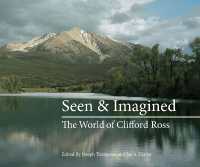- ホーム
- > 洋書
- > 英文書
- > History / World
基本説明
New in paperback. Hardcover was published in 2008. Contributors to this volume from anthropology, archaeology, environmental studies, geology, and biology show that human societies have been incredibly resilient and, in the long tun, have often recovered remarkably well from wide scale disruption and significant mortality.
Full Description
Popularist treatments of ancient disasters like volcanic eruptions have grossly overstated their capacity for death, destruction, and societal collapse. Contributors to this volume—from anthropology, archaeology, environmental studies, geology, and biology—show that human societies have been incredibly resilient and, in the long run, have often recovered remarkably well from wide scale disruption and significant mortality. They have often used eruptions as a trigger for environmental enrichment, cultural change, and adaptation. These historical studies are relevant to modern hazard management because they provide records for a far wider range of events and responses than have been recorded in written records, yet are often closely datable and trackable using standard archaeological and geological techniques. Contributors also show the importance of traditional knowledge systems in creating a cultural memory of dangerous locations and community responses to disaster. The global and temporal coverage of the research reported is impressive, comprising studies from North and Central America, Europe, Asia, and the Pacific, and ranging in time from the Middle Palaeolithic to the modern day.
Contents
1: Beyond Gloom and Doom: The Long-Term Consequences of Volcanic Disasters; 2: The Campanian Ignimbrite Factor: Towards a Reappraisal of the Middle to Upper Palaeolithic 'Transition'; 3: Chaos and Selection in Catastrophic Environments: Willaumez Peninsula, Papua New Guinea; 4: People and Volcanoes in the Zapotitan Valley, El Salvador; 5: Paleoindians and Megafaunal Extinction in the Basin of Mexico: The Role of the 10.5 K Upper Toluca Pumice Eruption; 6: Living with the Volcano: The 11 th Century AD Eruption of Sunset Crater; 7: Ecological Roadblocks on a Constrained Landscape: The Cultural Effects of Catastrophic Holocene Volcanism on the Alaska Peninsula, Southwest Alaska; 8: The Long Shadow: Understanding the Influence of the Laki Fissure Eruption on Human Mortality in Europe; 9: Volcanic Oral Traditions in Hazard Assessment and Mitigation; 10: Geomythology, Theodicy, and the Continuing Relevance of Religious Worldviews on Responses to Volcanic Eruptions; 11: Planning for the Future: A Multidisciplinary Approach to Reconstructing the Buag Episode of Mt Pinatubo, Philippines; 12: Archaeology of Fire and Glass: Cultural Adoption of Glass Mountain Obsidian; 13: Beyond the Catastrophe: The Volcanic Landscape of Barú, Western Panama








